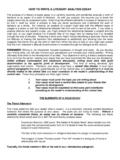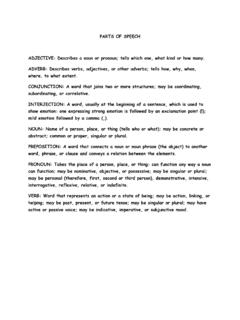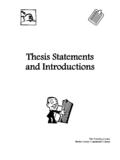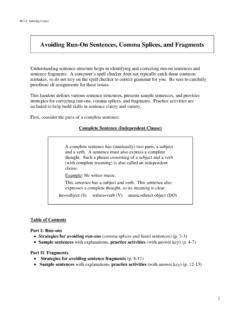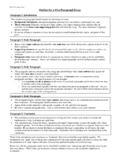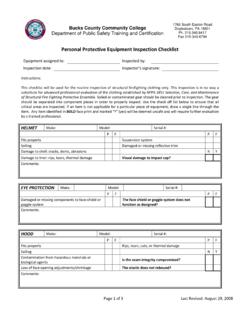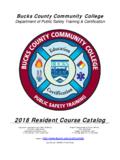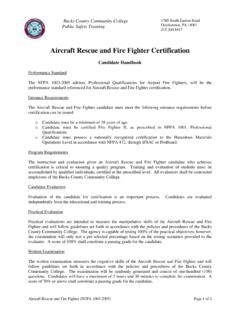Transcription of Glossary of Literary Terms - Think Smart
1 BCCC ASC Rev. 3/2019 Glossary of Literary Terms When writing a Literary analysis or a poetic explication, the student s job is to ask how the writer says what he or she is saying and why. Examining the how and why is analysis and the process involves reading closely to see which tools the writer has purposely employed to develop a specific effect or meaning. Allegory A narrative in which the characters, actions, and sometimes the setting, symbolically represent an idea, moral, or political or religious principles. Examples: Plato s Allegory of the Cave, Christ s parables of the prodigal son, Dante s Divine Comedy, Aesop s beast fables or Orwell s Animal Farm, the X-Men comics (an allegory for the Civil Rights Movement) Alliteration Repetition of the same consonant sounds in two or more words (usually at the beginning of the words, but sometimes on the stressed syllables) Uses: adds music to a line, makes a phrase memorable or distinctive, or reflects the content of the verse (cf.)
2 Onomatopoeia). Example: "Whereat, with blade, with bloody blameful blade, / He bravely breach'd his boiling bloody breast." (Shakespeare, A Midsummer Night s Dream, ) Allusion A direct or indirect reference to a person, place, thing, event, or idea in history or literature. Allusions imply reading and cultural experiences shared by the writer and the reader, functioning as a kind of shorthand whereby the recalling of something outside the text supplies an emotional or intellectual context. Use the verb form, allude. Example: At the outset of his I Have a Dream speech, Martin Luther King, Jr. says, Five score years ago, an allusion to Lincoln s Gettysburg Address, which begins Four score and seven years ago.
3 King alludes to Lincoln in order to draw a parallel between the historic moment of emancipation and his own time during the Civil Rights Movement. Antithesis a balanced statement; a figure of speech in which words and phrases with opposite meanings are balanced against each other. Example: To err is human, to forgive, divine (Pope, An Essay On Criticism ). Example: It was the best of times, it was the worst of times. (Dickens, A Tale of Two Cities,) Apostrophe to turn away from the general audience of a work to address a specific group, person, or thing (see Personification), including those that are absent, dead, or imaginary.
4 Often, the address is preceded by O or Oh. Example: For Brutus, as you know, was Caesar's angel / Judge, O you gods, how dearly Caesar loved him! (Shakespeare, Julius Caesar, ) Here, the speaker, Antony, is addressing a crowd, but briefly addresses the gods mid-speech in an apostrophe. Assonance The repetition of vowel sounds in stressed syllables (see also Alliteration). Assonance differs from rhyme in that rhyme is a similarity of vowel and consonant: "lake" and "fake" demonstrate rhyme, "lake" and "fate demonstrate assonance. Hear the mellow wedding bells (Poe, The Bells ) BCCC ASC Rev. 3/2019 Ballad A narrative poem that tells a story Example: The Rime of the Ancient Mariner, by Samuel Taylor Coleridge Blank Verse Iambic pentameter (see Meter) without rhyme.
5 The verse form closest to the natural rhythms of English speech. Example: Most of the content of Shakespeare s plays; Milton s Paradise Lost Caesura A pause occurring in a line of poetry , either due to sense or to natural speech rhythm. A caesura is usually accompanied by some form of punctuation. It is conventional to notate a caesura with the double pipe sign: || Example: How do I love thee? || Let me count the ways (Elizabeth Barrett Browning, How Do I Love Thee?, Sonnet 43) Chiasmus - An inversion of the second of two parallel phrases ( do not live to eat but eat to live). It is named after the Greek letter chi (x), indicating a crisscross arrangement of Terms .
6 ( we drive on the parkway and park on the driveway). Clich An expression that has lost its freshness or appeal due to overuse. Examples: the writing is on the wall, as easy as pie, what goes around comes around, or turn over a new leaf Climax moment of greatest intensity or emotional tension as a narrative s conflict is reached, usually marks a turning point in the plot. Example: In Star Wars: A New Hope, the climax is when Luke Skywalker, harnessing the Force with help from his deceased mentor, is able to fly up to and shoot the exact point that destroys the Death Star, just as it is about to destroy the rebel base. Conceit a figure of speech (such as an analogy, metaphor, hyperbole, or oxymoron) which sets up an unusual, exaggerated, or elaborate parallel between two different things (for example, comparing one s beloved to a ship or planet.)
7 The comparison may be brief or may extend throughout an entire poem. Example: In Valediction: Forbidding Mourning John Donne includes an extended metaphor comparing the souls of himself and his lover to a drafting compass: If they be two, they are two so / As stiff twin compasses are two; The poem continues to build on this image until its conclusion. Conflict The struggle or tension within the plot between opposing forces. Denouement the outcome or resolution of the plot. Diction A writer s specific choice of words, phrases, sentence structures, and figurative language, which combine to create meaning. Discussions about diction consider why the writer uses this word rather than any other word that might have the same literal meaning.
8 Drama A Literary genre usually in the form of a story or play that focuses on and resolves some universal problem or situation. Echo - the repetition of key words, sounds, syllables, lines or ideas for effect. Elegy A formal poem lamenting about the dead. BCCC ASC Rev. 3/2019 End-stop a natural pause indicated by punctuation such as a period or comma at the end of a line. Enjambment when a sentence steps over a line break into the next line without pause. Examples of end-stop and enjambment from Shakespeare s Sonnet 130. The first line is end-stopped; the last two are enjambed. o My mistress when she walks treads on the ground..end-stopped And yet, by heaven, I Think my love as rare.
9 As any she belied with false compare..enjambment Epic A long narrative poem about the deeds of a hero, often set in a past that is depicted as greater than the present. Epigram Originally a brief poem, usually solemn, but now usually refers to a short poem with a cutting remark at the end. Euphemism Mild or indirect words replacing harsher or more direct words Example: he passed away instead of he died. Figurative Language also called Figures of Speech describe something as one thing when it is another; it is the opposite of literal language. Example: Shakespeare s phrase My love is a fever (Sonnet 147) is figurative because love is not a high body temperature.
10 The phrase, rather, might describe the speaker s emotion in an alternative way to express the degree of feeling or the idea of being stricken with a condition. Figurative language can be found in: allegory, apostrophe, conceit, hyperbole, irony, litotes, metonymy (and synecdoche), oxymoron, paradox, personification, simile, and symbolism. Foot the basic unit of rhythm in poetry consisting of a group of two or three syllables. For example, a line of poetry ten syllables long written in iambs (an unstressed syllable followed by a stressed syllable) would be iambic pentameter. Note that variation is important in poetry ; therefore, the prevailing foot may be spotted with different feet.
